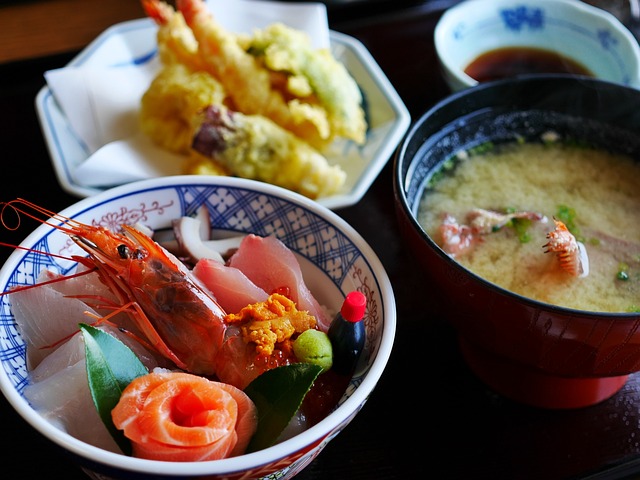“Mame chishiki = Trivia”
和食と言えば「旨み」と言われているほど、和食と旨みは切っても切れない関係。
旨みとは、食べ物や飲み物の中で感じる美味しさや深みのこと。
和食を食べたときの舌に感じる優しい旨みは、心も癒されるような感じがしますよね。
そんな旨みについて深掘りしていきたいと思います。
Explore the charm of the umami that is the key to Japanese cuisine! A well-balanced secret
Japanese food and umami are inseparable, so much so that umami is said to be the word when it comes to Japanese food.
Umami refers to the deliciousness and depth of taste experienced in food and drinks.
When you eat Japanese food, the gentle flavor that hits your tongue feels soothing to your soul.
I would like to dig deeper into this flavor.
食材の酸から生まれる
旨みは、食材に含まれる20種類のアミノ酸系から生まれます。
アミノ酸とはタンパク質からなるグルタミン酸や、新しい細胞をつくるのに欠かせないイノシン酸などの成分です。
これらの成分は、肉や魚、乾燥した海藻、しいたけなどにたくさん含まれています。
和食の出汁には、グルタミン酸が含まれる昆布やイノシン酸が含まれるカツオやイワシなど多く使われているため、旨みがグッと引き出されているんですよ。
また旨みは食材をコトコト煮込んだり、焼いたりと火を加えることで増加します。
煮込む料理が多い和食は旨みの宝庫だったんですね。
produced from food acids
Umami comes from the 20 types of amino acids contained in ingredients.
Amino acids are components such as glutamic acid, which is made up of proteins, and inosinic acid, which is essential for creating new cells.
These ingredients are found in abundance in meat, fish, dried seaweed, and shiitake mushrooms.
Japanese soup stock often uses kelp, which contains glutamic acid, and bonito and sardines, which contain inosinic acid, which bring out the flavor.
Umami is also increased by adding heat to ingredients, such as boiling or grilling them.
Japanese cuisine, which often involves stewing, was a treasure trove of flavor.

甘みと苦みの相乗効果
和食はサトウキビから取れる砂糖や蜂蜜などの自然の甘みを加えて、料理にコクを与えます。
甘みがあることで舌あたりがまろやかになり、「美味しい」と感じますよね。
和食にふんだんに使われている野菜本来の甘みもあり、特にカボチャやイモ類は優しい甘さがあるのが特徴。
一方、ミョウガや春菊、山菜などは独特の苦みがあり、料理をグッと締めてくれます。
甘みと苦みの相乗効果から和食の美味しさが生まれると言ってもいいでしょう。
Synergistic effect of sweetness and bitterness
Japanese cuisine adds natural sweetness such as sugar from sugar cane and honey to give the dishes a richer flavor.
The sweetness makes it mellow on the tongue, making it feel delicious.
Vegetables that are abundantly used in Japanese cuisine also have a natural sweetness, and pumpkins and potatoes in particular have a gentle sweetness.
On the other hand, Japanese ginger, garland chrysanthemums, and wild vegetables have a unique bitterness that adds flavor to the dish.
It can be said that the deliciousness of Japanese food is born from the synergistic effect of sweetness and bitterness.
自然の香りと風味
食材の香りや風味は、食事の満足感に大きな影響を与えます。
美味しそうな匂いを嗅いだだけでお腹がすくこともありますよね。
様々な食材から作られる出汁と、香り豊かな野菜などが合わさった香りも旨みのひとつ。
和食の上品で優しい、どこか癒される味わいも旨みの魅力なんですよ。
natural aroma and flavor
The aroma and flavor of ingredients have a big impact on how satisfying a meal is.
Sometimes just smelling something delicious can make you hungry.
The aroma that comes from the combination of soup stock made from a variety of ingredients and aromatic vegetables is also part of the umami flavor.
The elegant, gentle, and somewhat soothing taste of Japanese food is also part of its appeal.

まとめ:新鮮な食材から成り立つ旨み
なんといっても旨みを引き立てるのは、新鮮な食材たち。
海に囲まれ豊かな風土の日本では、鮮度の高い食材が豊富です。
新鮮な魚介類や季節の野菜は、そのままの味わいが楽しめますよね。
食材の旨みを堪能して和食をもっと楽しみたい今日この頃です。
Umami made from fresh ingredients
After all, what brings out the flavor is the fresh ingredients.
Japan, which is surrounded by the sea and has a rich climate, has an abundance of fresh ingredients.
You can enjoy the flavor of fresh seafood and seasonal vegetables as they are.
Nowadays, I want to enjoy Japanese food even more by savoring the flavor of the ingredients.



コメント